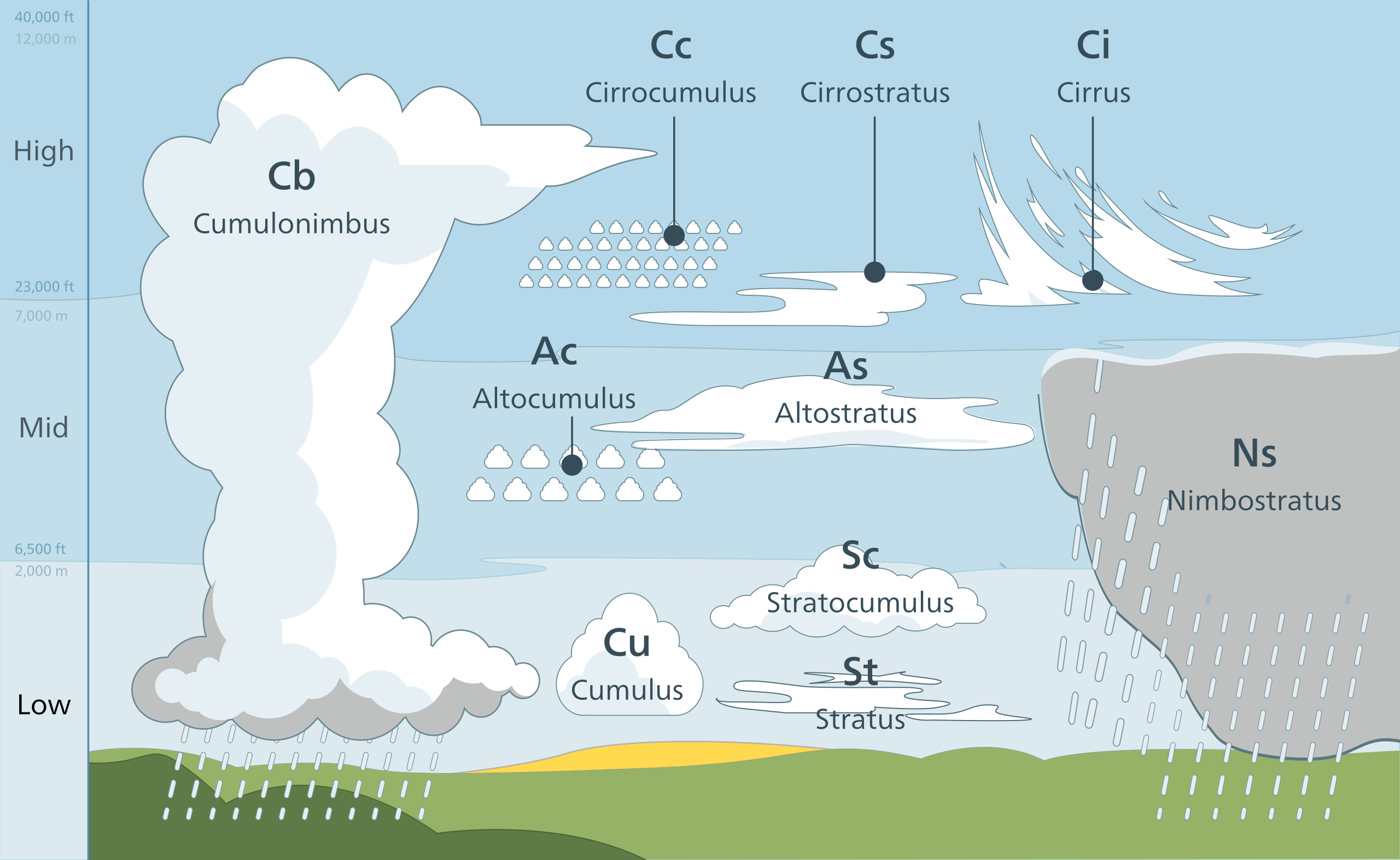
Credit: USGS, via Wikimedia Commons
We’ve all seen puffy cumulus clouds marching across the sky like a herd of elephants, perhaps changing shape into mythical creatures.
But did you ever stop to wonder—how much do those clouds weigh? I’ll give you a hint: it has to do with the elephants.
Cumulus clouds form when warm updrafts carry water vapor into the sky, until it begins to condense into water droplets.
These are so small that the updraft can overcome their gravity and keep them aloft.
The process of condensation produces more heat, which perpetuates the updraft and keeps the water vapor rising and condensing, to eventually become the white clouds we see from Earth.
These typically form thousands of meters up. Since they’re so far away, they may not look huge to us. But they can often be over a cubic kilometer in size.
Scientists multiplied that size by the average density of a cumulus cloud—about 5 grams per cubic centimeter—to calculate that a typical cloud weighs 500 million grams...or 1.1 million pounds!
That’s equivalent to 100 average-sized elephants, and more than our largest airplanes.
Why, then, does a cloud not fall from the sky?
Unlike elephants and airplanes, clouds are very low density because water molecules weigh less than the oxygen and nitrogen making up the dry air surrounding them—which means the cloud can stay aloft until the water vapor dissipates and the cloud fades away.
Background
Synopsis: One of the delights of fair blue skies are the puffy cumulus clouds that stir our imaginations as they evolve from shape to shape while floating overhead like helium balloons. But these cumulus clouds are made of water vapor, so they have weight—a lot of it! Why don’t they fall out of the sky?
- Cumulus clouds might be Earth’s simplest and most benign clouds.
- Cumulus clouds may be described as “puffy” or “fluffy” heaps of clouds that generally form at altitudes of 6,600 ft (2,000 m) or less. They are the clouds that we have been drawing since we were kids.
- Depending on your imagination, these clouds may form whimsical shapes that transform minute by minute, but they don’t usually produce any precipitation.
- They often evolve into more menacing clouds that do produce precipitation like cumulonimbus thunderheads.

Tropospheric cloud classification by altitude of occurrence.
Credit: Valentin de Bruyn/Coton, via Wikimedia Commons
- Like wind, cumulus clouds form because of differences in temperature.
- On a fair day, as Earth is warmed by the sun, darker areas absorb more heat while lighter areas reflect heat, staying cooler.
- As the darker areas warm, they radiate heat back into the atmosphere, creating warm air currents that expand and rise upward as less dense columns through the surrounding cooler, denser air.
- Warmer air holds more water vapor, so updrafts concentrate water molecules.
- As the warm air columns rise, they reach a level where condensation begins to occur as the temperature drops, creating larger droplets that are visible as a cloud.
- This “lifting condensation level” depends upon humidity as well as temperature and will define the flat base of cumulus clouds in still air. Cloud bases form at lower elevations when it is humid and higher elevations when it is dry.

Flat-based cumulus clouds over a Ukrainian field in 2016.
Credit: Novoklimov, via Wikimedia Commons - Cloud water droplets are so small that warm updrafts easily overcome the pull of gravity, keeping them aloft.
- Condensation is a chemical reaction that releases heat, constantly generating internal heat that keeps the updraft moving upward, even if the cloud moves away from the place where it was generated.
- Researchers at the United States Geological Survey have calculated the mass of a typical cumulus cloud at 1.1 million pounds, equivalent to the mass of 100 average-sized African bush elephants.

A group of African bush elephants in Amboseli National Park, south Kenya.
Credit: Benh LIEU SONG, via Wikimedia Commons- They took the volume of a one-kilometer cube—one billion cubic meters—and using the average density of a cumulus cloud (0.5 g/cc) determined that there are about 500 million grams of water in a cloud.
- That means the puffy cloud weighs around 500,000 kg, or 1.1 million pounds.
- That’s about 100 elephants at 11,000 pounds average each.
- The maximum weight of a 747-400 aircraft is less at 910,000 pounds (412,000 kg).
- So why aren’t cumulus clouds falling out of the sky?
- Dry air is made up of 78% nitrogen (N2 molecules) and 21% oxygen (O2 molecules). A nitrogen atom weighs 14 atomic mass units (amu) so a nitrogen molecule weighs 14+14=28 amu. An oxygen atom weighs 16 amu so an oxygen molecule weighs 16+16=32 amu.
- A water vapor molecule (H2O) weighs just 1+1+16=18 amu. As humidity increases, air becomes less and less dense as water molecules take the space that heavier nitrogen and oxygen molecules might otherwise occupy.

A puffy cumulus cloud in a bright blue sky.
Credit: Lance Vanlewen, via Wikimedia Commons - Moist clouds are less dense at a molecular level than clear dry air, so they float above dry air masses.
- These dry air masses between the ground and the cloud weigh more than the clouds. But both are very low density.
- The mass of the airplane is concentrated into a much smaller volume; it is much denser than the cloud and will fall out of the sky.
- Same for the 100 elephants.

